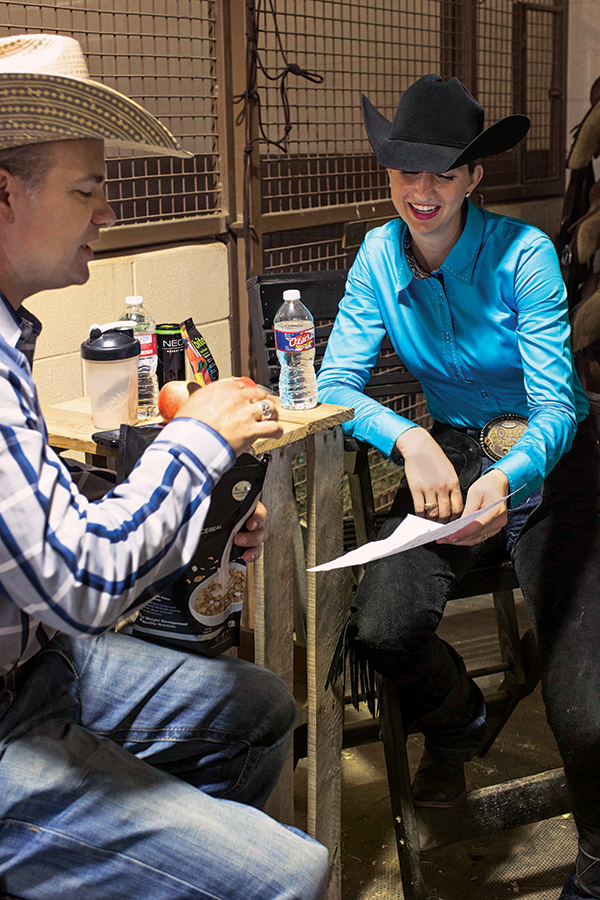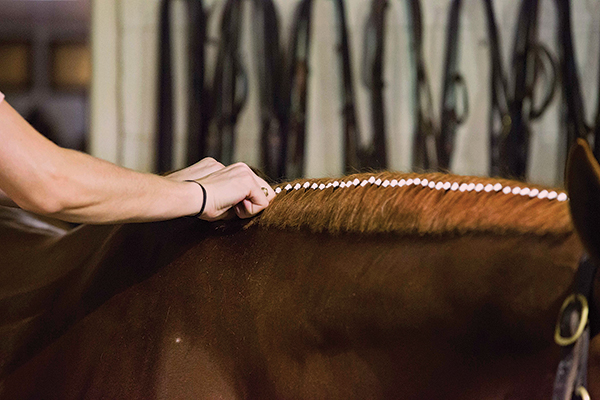Seasoned veterans and newbie novices share one horse-show challenge: juggling downtime. Horse shows inherently possess a “hurry-up-and-wait” scenario, but you don’t have to twiddle your thumbs with anxiety as you wait for hours, picking at your horse and arriving at the in-gate keyed up. You also don’t want to misjudge the timing of the classes before yours and rush to the pen stressed and unprepared—or worse, miss your class.

I’ve worked with my youth and amateur clients to develop routines and rhythms to help my exhibitors enter the show pen calm and ready to compete. Here’s my list of do’s and don’ts to help you devise your own program to manage your show down time to your advantage.
Do fuel your body. I admit: I used to neglect the importance of a rider keeping her body fueled throughout the day. I credit my wife for showing me that riders (and trainers/coaches!) need to eat and drink to keep going during the long day. You never know when you’ll have time to eat—or when you think you will but don’t—so nutrition and hydration are very important.
Choose healthy food to fuel your body. Pack good sources of protein that you can keep in a cooler, such as grilled chicken, beef, or fish. I add a protein shake as well. Drink plenty of water, and don’t forget healthy carbs such as veggies, fruits, and legumes. Avoid processed snacks, candy, and soda—typical concession-stand fare—that might provide a quick pick-me-up but inevitably lead to an energy crash.
Don’t fly by the seat of your pants. During downtime, make extra-sure you know your pattern. Go over it in your head and walk it out on foot. Plan how you’re going to execute the pattern or your class. Map out when you’re going to get ready for your class—will it be during the class that’s two classes before yours? Will it be during the rail work or the pattern? How long will it take you to get your horse ready? Is he more tired today or less? Will your horse need more work to be ready today? There are so many factors that build into your preparation work, so take all of that into consideration.
Don’t miss a feeding. Fuel is just as important for your horse as it is for you. And a happy horse—one that’s not hungry—wants to perform for you and will show his interest in competition.
If, as you’re getting ready, it’s getting close to feeding time, go ahead and feed your horse a little early. If you wait until after you practice or warm up, those routines could run longer than you expected and put you past feeding time and closer to the time you’ll show. Err on the side of early to keep your horse fed and happy.
Don’t overpractice the pattern. Just because you find yourself with an extra 20 minutes doesn’t mean you should spend every second drilling your pattern on your horse. It’ll burn out your horse and lead to anticipation. Practicing on foot is fine; but over-practicing in the saddle leads to trouble.
I recommend practicing individual maneuvers, especially if the pattern contains something that’s more difficult. Test your most challenging maneuvers a few times. Once you get it, there’s no sense hammering on your horse and wearing him out because you want to practice the pattern 50 times. If you’re worried and you exhaust (and annoy) your horse about it, that can create issues that go well past that show. Have enough confidence to step up and do the maneuver in the show pen the way you would do it every day.
Do save your horse’s peak performance. If you’re at a horse show that lasts a week to 10 days, save your horse’s best work by avoiding a lot of practice.

When there’s a 10-hour show day, and each class has a warm-up time, there’s a lot that a horse has to do in the day. The less practice you can put in at a show, the better. Focus on keeping your horse soft, balanced, and interested in his job. The more you go out and practice hard pattern after hard pattern at the show, the more he’ll wear down and lose his mental sharpness.
Do time the classes before you. One of the hardest things for competitors is estimating how long it’s going to be until your class starts. Watch a couple of the runs in the classes before yours. Time a couple of the patterns from the moment they walk in the gate until the next rider’s turn begins, then make a conservative estimate. Take into account that some patterns are longer than others. Novice patterns especially tend to be a bit shorter. Pay attention to scratches too, as they’ll shorten the time until your class or run.
Don’t miss your five-minute countdown. This is the big one. It doesn’t matter how hard you’ve practiced the day before, the week before, or the year before. If you get upset or you’re not focused or you’re distracted in those last five minutes before you go into the pen, you’ll mess up the short time you have to make an impression on the judge during your pattern. Once that time is gone, it’s hard to get back on track.
Know when to get on and have your horse ready, and when to walk around softly and prepare your mind. If you get on and you’re kicking and bumping and jerking—basically telling your horse he can’t do anything right—then your horse will get defensive. Go back to the foundation drills: the two-track, the stop, the back, a turnaround, and gait transitions. Stay soft, quiet, and patient. If you use your legs and hands to punish your horse right before you go in to show, he’ll most certainly show an attitude when you cue him in competition.
When you have two or three classes a day, you’ll repeat your preparation process each time to some degree. But the last five minutes of your horse-show prep and getting on at the right time are the hardest parts of preparing to compete. Once your nerves start to settle in and you get a little anxious, doing drills that quiet your mind during the last five minutes will help calm you down.
Do make the most of downtime. It’s not a good idea to sit around at a show. Inactivity gives you too much time to get nervous. There’s a benefit to being able to take care of your own horse, clean his stall, and provide him with feed and water: It keeps you busy and engaged with your horse.
Brad Jewett, Boerne, Texas, is an AQHA Professional Horseman and has been training horses for 24 years. He started in reining and began training all-around horses 16 years ago. He’s guided riders to many accomplishments, including the 2010 and 2011 AQHYA horsemanship world championships, as well as multiple world and reserve world champions in other events and multiple All American Quarter Horse Congress champions. Learn more at jewettperformancehorses.com.






